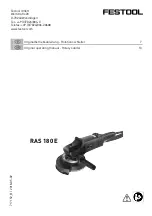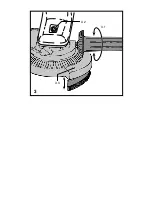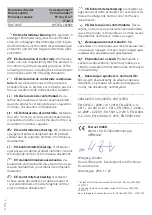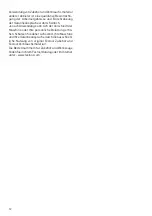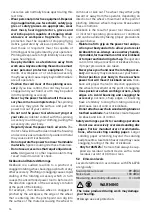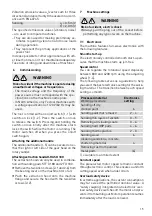
14
cessories will normally break apart during this
test time.
-
Wear personal protective equipment. Depend-
ing on application, use face shield, safety gog-
gles or safety glasses. As appropriate, wear
dust mask, hearing protectors, gloves and
workshop apron capable of stopping small
abrasive or workpiece fragments.
The eye
protection must be capable of stopping fl ying
debris generated by various operations . The
dust mask or respirator must be capable of
fi ltrating particles generated by your operation.
Prolonged exposure to high intensity noise may
cause hearing loss.
-
Keep bystanders a safe distance away from
work area. Anyone entering the work area must
wear personal protective equipment.
Frag-
ments of workpiece or of a broken accessory
may fl y away and cause injury beyond immediate
area of operation.
-
Position the cord clear of the spinning acces-
sory.
If you lose control, the cord may be cut or
snagged and your hand or arm may be pulled
into the spinning accessory.
-
Never lay the power tool down until the acces-
sory has come to a complete stop.
The spinning
accessory may grab the surface and pull the
power tool out of your control.
-
Do not run the power tool while carrying it at
your side.
Accidental contact with the spinning
accessory could snag your clothing, pulling the
accessory into your body.
-
Regularly clean the power tool’s air vents.
The
motor’s fan will draw the dust inside the housing
and excessive accumulation of powdered metal
may cause electrical hazards.
-
Do not operate the power tool near fl ammable
materials.
Sparks could ignite these materials.
-
Do not use accessories that require liquid cool-
ants.
Using water or other liquid coolants may
result in electrocution or shock.
Kickback and Related Warnings
Kickback is a sudden reaction to a pinched or
snagged rotating wheel, backing pad, brush or any
other accessory. Pinching or snagging causes rapid
stalling of the rotating accessory which in turn
causes the uncontrolled power tool to be forced in
the direction opposite of the accessory’s rotation
at the point of the binding.
For example, if an abrasive wheel is snagged or
pinched by the workpiece, the edge of the wheel
that is entering into the pinch point can dig into
the surface of the material causing the wheel to
climb out or kick out. The wheel may either jump
toward or away from the operator, depending on
direction of the wheel’s movement at the point of
pinching. Abrasive wheels may also break under
these conditions.
Kickback is the result of power tool misuse and/
or incorrect operating procedures or conditions
and can be avoided by taking proper precautions
as given below.
-
Maintain a fi rm grip on the power tool and po-
sition your body and arm to allow you to resist
kickback forces. Always use auxiliary handle,
if provided, for maximum control over kickback
or torque reaction during start-up.
The operator
can control torque reactions or kickback forces,
if proper precautions are taken.
-
Never place your hand near the rotating acces-
sory.
Accessory may kickback over your hand.
-
Do not position your body in the area where
power tool will move if kickback occurs.
Kick-
back will propel the tool in direction opposite to
the wheel’s movement at the point of snagging.
-
Use special care when working corners, sharp
edges etc. Avoid bouncing and snagging the
accessory.
Corners, sharp edges or bouncing
have a tendency to snag the rotating accessory
and cause loss of control or kickback.
-
Do not attach a saw chain woodcarving blade or
toothed saw blade.
Such blades create frequent
kickback and loss of control.
Safety warnings specifi c for sanding operations
-
Do not use excessively oversized sanding disc
paper. Follow manufacturers recommenda-
tions, when selecting sanding paper.
Larger
sanding paper extending beyond the sanding
pad presents a laceration hazard and may cause
snagging, tearing of the disc or kickback.
-
Only for AS/NZS:
The tool shall always be sup-
plied via residual current device with a rated
residual current of 30 mA or less.
5.3 Emission
levels
Levels determined in accordance with EN 60745
are typically:
Sound pressure level
89 dB(A)
Noise level
100 dB(A)
Measuring uncertainty allowance
K = 3 dB
WARNING
The noise produced during work may damage
your hearing.
Always use ear protection.

